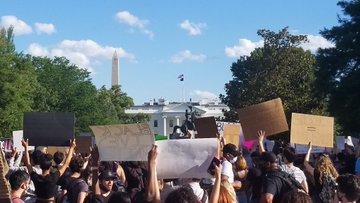Radiofarda – Recent protests and unrest in the United States, treatment of protesters by U.S. law enforcement in comparison with Iran, and the approach of the highly censored Iranian media to the issue have become hot topics in Persian-language social media in the past few days.
Regime supporters have been attacking dissidents who they say are always ranting about regime suppression but are now “mum” about what is happening in the United States. The Iranian state-run television has been devoting a lot of attention to the protests while the Foreign Ministry Spokesman Seyed Abbas Mousavi, has urged the U.S. government “to stop the violence” and to “listen to the voice of protesters”.
In response to U.S. National Security Adviser Robert O’Brien’s allegations that countries such as Iran were trying to exploit the protests, Mousavi on Monday said it is the United States, not Iran, that meddles in the affairs of other countries.
Iran state-run TV (IRIB) reporter interviewing protesters in front of the White House. Dissidents are never interviewed during similar incidents in Iran.

همین الان، واشنگتن دی سی، جلوی کاخ سفید، خبرنگار صداوسیما
صداوسیما جان! کاش همینقدر مسئولانه از اعتراضات داخل ایران هم گزارش تهیه میکردی



94811:12 PM – May 31, 2020Twitter Ads info and privacy127 people are talking about this
When it comes to the recent protests in the United States, those who oppose the Iranian regime are divided, too. Some Iranian dissidents point out that the way the two governments deal with protests and unrest is fundamentally different. The Islamic Republic has a long record of brutality against protesters, shooting at defenseless people, killing them in the hundreds and putting others behind bars for nothing more than holding up placards or chanting, they say and maintain that protesters in the United States are not shot in the head as they are in Iran.
Others accuse those who defend the U.S. government – or remain silent about the issue — of of being biased. But they, too, agree that the Iranian regime is much more repressive, does not allow independent reporting of protests by the media and even shuts down the internet to prevent the news and footage of protests to reach domestic and foreign audiences.SEE ALSO:Hardliner Lawmaker Claims Less Than 200 Protesters Killed In Iran’s November Unrest
“When you see the regime lackeys going on about protests in the United States, remind them that if they are able to see footage of the protests as they happen is because the internet there is still working,” a Twitter user wrote.
“Right now, the reporter of the IRIB [Iranian State TV] is reporting from in front of the White House. Dear IRIB I wish you would report about protests in Iran with as much concern,” another user tweeted with photos of the IRIB reporter in Washington DC interviewing protesters.
Another Twitter user posted a composite photo of the front page of Iranian newspapers during the November 2019 protests in Iran that were completely censored ignoring the events. Next to it a photo of Iranian newspapers shows photos of U.S. protests on the front page of most dailies.
Images of unrest in United States on front pages. No mention of Iranian protest in November 2019.

این مقایسه صفحه اول چند روزنامهی ایرانه، واکنش به یک روز اعتراضات در آمریکا،
و صفحهاول خونین ترین روزهای سال گذشته آبان، روزنامههای کشور ما!


16:43 AM – Jun 1, 2020Twitter Ads info and privacySee belack_mehdi’s other Tweets
“Just imagine if the U.S. police kills not 1,500 or even 300 but just five by shooting at their heads in the protests in Minneapolis, and then they say they were rioters…What would the world think?,” another user tweeted with reference to the killing of hundreds of protesters by Iranian security forces in November many of whom were shot in the head.
In November 2019 protests against the tripling of the price of gasoline which quickly spread across the country were heavy-handedly suppressed. The regime for months refused to disclose the death toll. Only seven months later, on Sunday, Interior Minister Abdolreza Rahmani-Fazli admitted that around 200 protesters had been killed. Many believe the death toll is as high as 1,500.
- Maryam SinaieeMaryam Sinaiee is a British-Iranian journalist, political analyst and former correspondent of The National, who contributes to Radio Farda.
 Shabtabnews In this dark night, I have lost my way – Arise from a corner, oh you the star of guidance.
Shabtabnews In this dark night, I have lost my way – Arise from a corner, oh you the star of guidance.


